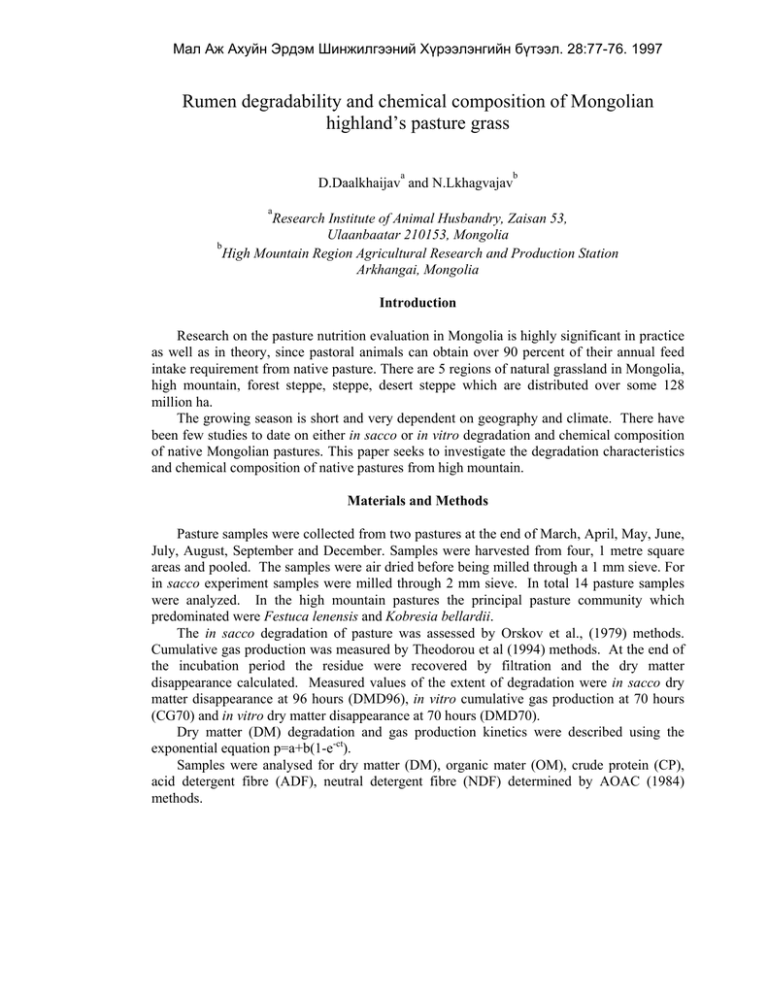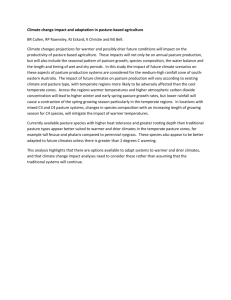Rumen degradability and chemical composition of Mongolian highland’s pasture grass
advertisement

Ìàë Àæ Àõóéí Ýðäýì Øèíæèëãýýíèé Õ¿ðýýëýíãèéí á¿òýýë. 28:77-76. 1997 Rumen degradability and chemical composition of Mongolian highland’s pasture grass a b D.Daalkhaijav and N.Lkhagvajav a Research Institute of Animal Husbandry, Zaisan 53, Ulaanbaatar 210153, Mongolia b High Mountain Region Agricultural Research and Production Station Arkhangai, Mongolia Introduction Research on the pasture nutrition evaluation in Mongolia is highly significant in practice as well as in theory, since pastoral animals can obtain over 90 percent of their annual feed intake requirement from native pasture. There are 5 regions of natural grassland in Mongolia, high mountain, forest steppe, steppe, desert steppe which are distributed over some 128 million ha. The growing season is short and very dependent on geography and climate. There have been few studies to date on either in sacco or in vitro degradation and chemical composition of native Mongolian pastures. This paper seeks to investigate the degradation characteristics and chemical composition of native pastures from high mountain. Materials and Methods Pasture samples were collected from two pastures at the end of March, April, May, June, July, August, September and December. Samples were harvested from four, 1 metre square areas and pooled. The samples were air dried before being milled through a 1 mm sieve. For in sacco experiment samples were milled through 2 mm sieve. In total 14 pasture samples were analyzed. In the high mountain pastures the principal pasture community which predominated were Festuca lenensis and Kobresia bellardii. The in sacco degradation of pasture was assessed by Orskov et al., (1979) methods. Cumulative gas production was measured by Theodorou et al (1994) methods. At the end of the incubation period the residue were recovered by filtration and the dry matter disappearance calculated. Measured values of the extent of degradation were in sacco dry matter disappearance at 96 hours (DMD96), in vitro cumulative gas production at 70 hours (CG70) and in vitro dry matter disappearance at 70 hours (DMD70). Dry matter (DM) degradation and gas production kinetics were described using the exponential equation p=a+b(1-e-ct). Samples were analysed for dry matter (DM), organic mater (OM), crude protein (CP), acid detergent fibre (ADF), neutral detergent fibre (NDF) determined by AOAC (1984) methods. Ìàë Àæ Àõóéí Ýðäýì Øèíæèëãýýíèé Õ¿ðýýëýíãèéí á¿òýýë. 28:77-76. 1997 Results and Discussion Festuca lenensis dominated pasture covers an area of about 10.6 million hectare in Mongolia. In general, the topography is high, with altitude above sea level ranging from 2300-2500 m. 100 square meter of the experimental field counted 35 (33-44) , totally about 50 species. Degree of ground coverage about 60 to 70 % in late July or middle of August. Where in this pasture subdominant species are Arenaria capillaris, Pulsatilla Turzaninovii. Animal consumable yield vary from 260 to 656 kg/ha (in air dry basis) according to the amount of rainfall and its distribution. Kobresia bellardii dominated alpine meadows are distributed over an area of about 3.3 million hectare in Mongolia. Experimental sites located 2500-2600 m above the sea level, lies north slope of the mountain. Degree of ground coverage about 65 to 75 % in middle of summer, height of grass layer 20-22 cm. 100 square meter of experimental sites counted 3040 of the plant species. Animal consumable yield varies between 480 to 800 kg/ha (in air dry basis) in middle of the summer. 30 to 40 % of the total yield belongs to Kobresia bellardii, 30-40 percent belongs to other forbs. Regardless of environmental conditions, alpine meadow's growth time length is less than 70 days. The summer maximum fresh yield occurs in the middle of August which is counted 1330 kg/ha. Rumen degradability The different indicators of the extent of degradation obtained from the gas production were highly correlated (CG70 vs DMD70, R2= 0.76; CG70 vs gas pool, R2=0.67), indicators from the in sacco technique were less highly correlated (a+b vs DMD96, R2=0.60). CG70 of Festuca lenensis dominated pasture were ranged from 242.4 ml/g DM to 289.4 ml/g DM depending on maturity stage of the dominant species of pasture. The peak CG70 obtained in beginning of the June, lowest were found in late of the March. CG70 of Kobresia bellardii dominated alpine meadow pasture were ranged from 207.82 ml/g DM to 255.7 ml/g DM. Kobresia bellardii dominated pasture’s CG70 were averaged 225.5 ml/g DM. DMD70 and OMD70 ranged from 64.6% to 80.3%; 66.2% to 80.4%, respectively. DMD96 were ranged from 63.7 to 82.4 %. “a” values were ranged from 6.2% to 26.3%. “b” values were ranged from 52.1% to 79.6%. Chemical composition CP content of Festuca lenensis dominated pasture ranged from 4.65% to 13.55%, NDF ranged from 58.46% to 75.63% and ADF ranged from 36.08% to 52.23% (Table1). Highest value of CP were found in begin July. Highest NDF in winter time. Kobresia bellardii dominated pasture contains CP from 4.74% to 17.25%. Highest value (70.19%) of NDF were found in end November, lowest (46.97%) were found 10th of June. Highest value (49.58%) of ADF were found in March, lowest value (33.11%) were found in June. Conclusions High mountains pasture had a marginally higher degradability compared to forest steppe and steppe. Based on results of analysis of pastures taken all-year-round, we subjectively group the time into 4 periods, i.e. before April, May-June, July-September, After September. The time periods also corresponds to vegetative stage of pasture grass. The ranking in degradability and degradation rate of these periods is generally: May-June > July-September > Before April > After September. Ìàë Àæ Àõóéí Ýðäýì Øèíæèëãýýíèé Õ¿ðýýëýíãèéí á¿òýýë. 28:77-76. 1997 For very fruitful use of rumen degradable capacity of died standing forage of pasture there is a great need to provide nitrogen and mineral supply through supplementation feeding during the winter-spring. Table 1.Chemical composition and nutritive value of Mongolian highland’s pasture grass. Date DM OM CP NDF ADF Hem Gas DMD OMD Festuca lenensis dominant pasture 93.12.24 93.73 89.70 4.65 75.63 52.23 23.39 258.10 67.72 70.15 94.03.26 93.74 90.84 5.94 70.93 50.33 20.60 242.37 64.63 66.21 94.06.10 94.03 93.59 12.19 58.62 36.08 22.55 289.44 80.31 80.4 94.07.04 93.97 91.16 13.55 59.03 42.24 16.79 259.05 73.28 73.62 94.07.28 93.92 92.22 11.49 58.46 39.69 18.77 257.51 72.64 72.94 94.08.12 94.19 90.39 10.60 61.68 41.19 20.49 247.30 71.1 72.36 94.08.25 93.88 91.83 9.56 59.37 42.40 16.98 246.94 69.32 70.01 Kobresia bellardii dominant pasture 93.11.24 93.25 89.80 6.55 70.19 49.13 21.06 220.75 62.69 64 94.03.26 94.07 89.79 4.74 64.87 49.58 15.29 215.14 61.5 63.3 94.06.10 93.57 90.96 17.25 46.97 33.11 13.86 255.74 74.98 76.09 94.07.09 93.27 90.69 14.84 55.40 38.87 16.53 242.25 74.13 74.19 94.08.04 93.28 89.12 10.89 60.79 43.86 16.93 218.75 64.36 65.09 94.08.16 92.92 89.66 10.57 57.66 42.61 15.06 207.82 63.59 63.99 94.08.27 92.78 89.42 10.29 64.58 46.38 18.20 217.74 60.62 61.85 Note: Hem-hemicellulose (%), Gas- Gas production over 70 hours incubation (ml/g dry sample). References A.O.A.O (Association of Official and Analytical Chemists). 1984. Official methods of Analysis. (14th Ed.). Association of Official Analytical Chemists, Washington. Theodorou, M.K., B. A. Williams, M.S. Dhanoa, A.D.B. McAllan and J. France. 1994. A simple gas production method using a pressure transducer to determine the fermentation kinetics of ruminant feeds. Anim. Feed Sci. Tech., 48:185-197. Orskov, E.R. and I. McDonald. 1979. The estimation of protein degradability in the rumen from incubation measurements weighted according to rate of passage. J. Agric. Sci., 92:499-503.








